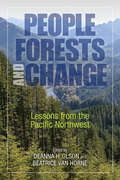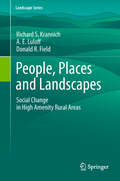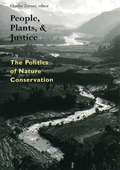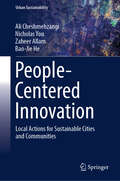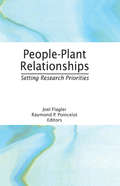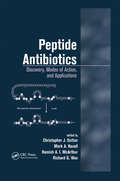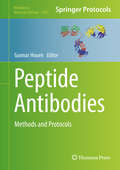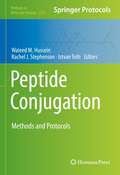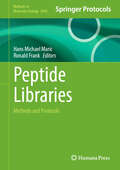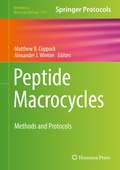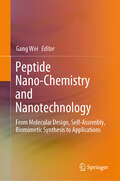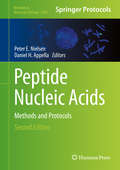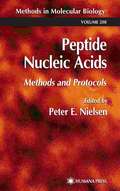- Table View
- List View
People, Forests, and Change: Lessons from the Pacific Northwest
by Beatrice Van Horne Deanna H. OlsonWe owe much of our economic prosperity to the vast forested landscapes that cover the earth. The timber we use to build our homes, the water we drink, and the oxygen in the air we breathe come from the complex forested ecosystem that many of us take for granted. As urban boundaries expand and rural landscapes are developed, forests are under more pressure than ever. It is time to forgo the thinking that forests can be managed outside of human influence, and shift instead to management strategies that consider humans to be part of the forest ecosystem. Only then can we realistically plan for coexisting and sustainable forests and human communities in the future.In People, Forests, and Change: Lessons from the Pacific Northwest, editors Deanna H. Olson and Beatrice Van Horne have assembled an expert panel of social and forest scientists to consider the nature of forests in flux and how to best balance the needs of forests and the rural communities closely tied to them. The book considers the temperate moist-coniferous forests of the US Pacific Northwest, but many of the concepts apply broadly to challenges in forest management in other regions and countries. In the US northwest, forest ecosystem management has been underway for two decades, and key lessons are emerging. The text is divided into four parts that set the stage for forests and rural forest economies, describe dynamic forest systems at work, consider new science in forest ecology and management, and ponder the future for these coniferous forests under different scenarios.People, Forests, and Change brings together ideas grounded in science for policy makers, forest and natural resource managers, students, and conservationists who wish to understand how to manage forests conscientiously to assure their long-term viability and that of human communities who depend on them.
People, Parasites, and Plowshares: Learning from Our Body's Most Terrifying Invaders
by Dickson DespommierDickson D. Despommier's vivid, visceral account of the biology, behavior, and history of parasites follows the interplay between these fascinating life forms and human society over thousands of years. Despommier focuses on long-term host-parasite associations, which have evolved to avoid or even subvert the human immune system. Some parasites do great damage to their hosts, while others have signed a kind of "peace treaty" in exchange for their long lives within them. Many parasites also practice clever survival strategies that medical scientists hope to mimic as they search for treatments for Crohn's disease, food allergies, type 1 diabetes, organ transplantation, and other medical challenges. Despommier concentrates on particularly remarkable and often highly pathogenic organisms, describing their lifecycles and the mechanisms they use to avoid elimination. He details their attack and survival plans and the nature of the illnesses they cause in general terms, enabling readers of all backgrounds to steal a glimpse into the secret work of such effective invaders. He also points to the cultural contexts in which these parasites thrive and reviews the current treatments available to defeat them. Encouraging scientists to continue to study these organisms even if their threat is largely contained, Despommier shows how closer dissection of the substances parasites produce to alter our response to them could help unravel some of our most complex medical conundrums.
People, Parks, and Power: The Ethics of Conservation-Related Resettlement (SpringerBriefs in Anthropology)
by Robert K. Hitchcock Maria SapignoliThis book presents a critical review of the ethics of conservation-related resettlement. We examine what has become known as the” parks versus people” debate, also known as the “new conservation debate,” which has pitted indigenous and other local people against nation states and social scientists against ecologists and conservationists for the past several decades. Aiming to promote biodiversity conservation and habitat preservation, some biologists, park planners, and conservation organizations have recommended that indigenous and other people should be removed from protected areas. Local people, for their part, have argued that residents of the areas that were turned into protected areas, national parks, game reserves and monuments had managed them in productive ways for generations and that they should have the right to remain there and to use natural resources as long as they do so sustainably. This position is often supported by indigenous rights organizations and social scientists, especially anthropologists. There are also some conservation-oriented NGOs that have policies involving a more human rights-oriented approach aimed at poverty alleviation, sustainable development, and social justice. The book discusses biodiversity conservation, indigenous peoples (those who are ethnic minorities and who are often marginalized politically), and protected areas, those categories of land set aside by nation-states that have various kinds of rules about land use and residence. The focus initially is on case studies from protected areas in the United States including Yellowstone National Park, Yosemite National Park, and Glacier National Park and on national monuments and historical parks where resettlement took place. We then consider issues of coercive conservation in southern Africa, including Hwange National Park (Zimbabwe), the Central Kalahari Game Reserve (Botswana), Etosha National Park, and Bwabwata National Park (Namibia), and Kgalagadi Transfrontier Park (South Africa and Botswana). All of these cases involved involuntary resettlement at the hands of the governments. In the book we consider some of the social impacts of conservation-forced resettlement (CfR), many of which tend to be negative. After that, we assess some of the strategies employed by indigenous peoples in their efforts to recover rights of access to protected areas and the cultural and natural resources that they contain. Examples are drawn from cases in Asia, Africa, and South America. Conclusions are provided regarding the ethics of conservation-related resettlement and some of the best practices that could be followed, particularly with regard to indigenous peoples.
People, Places and Landscapes
by Richard S. Krannich A. E. Luloff Donald R. FieldThis volume is a cogent empirical analysis of the interplay between a region's natural amenities and its socioeconomic evolution. It focuses on the rural sectors of America's Intermountain West region, which lies between the Cascades and Sierra Nevada mountains to the west and the Rocky Mountains to the east. Coherently structured and meticulously detailed, it adds much to our understanding of the ways an area's forests, lakes, mountains, parkland and historic attractions affect residents' sense of well-being as well as the sociodemographic and economic changes they experience. The book examines patterns of growth and change linked to the emergence of 'New West' conditions, assessing their implications for the wider community as well as discussing the impact these trends could have on the consumption of natural resources. It also points to ways in which communities and their development can be managed sustainably. The tight geographical focus of this valuable resource ensures a depth of analysis which can be applied to similar regions worldwide. Based on a large-scale, random-sample survey of both full-time and seasonal residents, it provides a much-needed overview of the macro-level economic, demographic, and social transformations affecting rural communities in America. As such, the book has relevance for all researchers concerned with rural development, the changes impacting rural landscapes, and natural resource management.
People, Plants, and Justice: The Politics of Nature Conservation
by Charles ZernerIn an era of market triumphalism, this book probes the social and environmental consequences of market-linked nature conservation schemes. Rather than supporting a new anti-market orthodoxy, Charles Zerner and colleagues assert that there is no universal entity, "the market." Analysis and remedies must be based on broader considerations of history, culture, and geography in order to establish meaningful and lasting changes in policy and practice.Original case studies from Asia, Latin America, Africa, and the South Pacific focus on topics as diverse as ecotourism, bioprospecting, oil extraction, cyanide fishing, timber extraction, and property rights. The cases position concerns about biodiversity conservation and resource management within social justice and legal perspectives, providing new insights for students, scholars, policy professionals and donor/foundations engaged in international conservation and social justice.
People-Centered Innovation: Local Actions for Sustainable Cities and Communities (Urban Sustainability)
by Ali Cheshmehzangi Zaheer Allam Bao-Jie He Nicholas YouAs a follow-up to the book titled &“Harnessing Urban Innovation to Unlock the Sustainable Development Goals&”, this collection examines transformative urban solutions through 15 internationally recognized case studies submitted to the 6th Guangzhou International Award for Urban Innovation in 2023. It provides valuable insights into the driving forces behind sustainable urban development, aligning closely with the United Nations' Sustainable Development Goals (SDGs). The main focus of the book is on people-centered approaches to urban innovation, demonstrating how grassroots initiatives can tackle complex urban challenges and contribute to global sustainability targets. Each case study presents innovative strategies implemented by communities worldwide, showcasing how local actions can greatly impact sustainability and resilience. The varied examples highlight a spectrum of urban issues, including affordable housing, sustainable transportation, climate adaptation, and social inclusion, reflecting the diverse nature of urban innovation. Key Features and Benefits: Varied Global Case Studies: The book includes fifteen case studies from different regions, each presenting unique solutions to urban challenges. These examples illustrate how various cultures and contexts address common problems, providing a rich array of ideas and practices. This makes it an essential resource for urban planners, policymakers, and community leaders seeking inspiration and guidance. Emphasis on People-Centered Approaches: The book emphasizes the importance of people-centered innovation, which prioritizes community involvement and local knowledge. By focusing on how local populations engage with and drive urban initiatives, the book highlights the significance of inclusivity and participatory processes in achieving sustainable outcomes. Alignment with the SDGs: Each case study is connected to specific Sustainable Development Goals, demonstrating how local actions contribute to global sustainability objectives. The book illustrates how grassroots initiatives address key areas such as poverty reduction, climate action, and sustainable cities and communities, highlighting the critical role of local efforts in achieving the broader SDG agenda.
People-Plant Relationships: Setting Research Priorities
by Joel Flagler Raymond P PoincelotPresenting the latest research on cross-cultural people-plant relationships, this volume conveys the psychological, physiological, and social responses to plants and the significant role these responses play in improved physical and mental health. With chapters written by field experts, it identifies research priorities and methodologies and outlines the steps for developing a research agenda to aid horticulturalists in their work with social scientists to gain a better understanding of people-plant relationships. This resource covers a wide array of topics including home horticulture and Lyme disease, indoor plants and pollution reduction, and plants and therapy.
Peppers
by Dr Vincent M. Russo Dr Nabi Chaudhary Dr Michael Balick Dr W Hardy Eshbaugh Dr Amit Krishna DeThe group of plants known as 'peppers' is diverse, containing types that contribute to the fresh and processed food markets as well as varieties that are used in pharmaceuticals and other non-food commercial products. Peppers originally developed in tropical regions, but are now grown and used in every country where it is possible to grow them, including in areas where production is difficult. This book examines peppers from historical, genetic, physiological and production perspectives, following the development of the cultivated crop from the wild type. Diverse examples of pod types and their variation in pungency are examined. Production methods, including the importance of fertilization and irrigation are discussed, as are constraints on production, including pests, pathogens and weeds. Harvesting methods and post-harvest challenges and opportunities are also explored.
Peppers
by Professor Paul Bosland Eric VotavaAlthough thought of as a minor crop, peppers are a major world commodity due to their great versatility. They are used not only as vegetables in their own right but also as flavourings in food products, pharmaceuticals and cosmetics. Aimed at advanced students and growers, this second edition expands upon topics covered in the first, such as the plant's history, genetics, production, diseases and pests, and brings the text up to date with current research and understanding of this genus. New material includes an expansion of marker-assisted breeding to cover the different types of markers available, new directions and trends in the industry, the loss of germplasm and access to it, and the long term preservation of Capsicum resources worldwide.
Peptide Analysis Protocols
by Ben M. Dunn Michael W. PenningtonIn this second volume of a two-volume set, state-of-the-art methods are given for the analysis of peptides. Leading authorities provide reproducible protocols for peptide analysis using HPLC, capillary zone electrophoresis, mass spectrometry, UV and fluorescence spectroscopy, to name a few. The authors describe the procedures in a practical, step-by-step fashion suitable for both experts or novices. Chapters also include a helpful Notes section offering troubleshooting tips, alternative procedures, details on substituting unavailable materials, and informative explanations about why certain steps are necessary. These extra measures help to guarantee the successful outcome of your experiments. Dunn and Pennington's Peptide Analysis Protocols offers a comprehensive collection of standard, readily reproducible methods for many procedures that will enable scientists in every area of biochemical and biological research to analyze those peptides that have been synthesized in the laboratory.
Peptide Antibiotics: Discovery Modes Of Action And Applications
by Christopher J. Dutton Mark A. Haxell Hamish A. I. McArthur Richard G. WaxThis reference summarizes the latest research on the structure, function, and design of synthetic and natural peptide antibiotics, describing practical applications of these compounds in food preservation and packaging, and in the prevention and treatment of infectious diseases by direct anti-bacterial action and as part of the adaptive immune resp
Peptide Antibodies
by Gunnar HouenThis extensive volume covers basic and advanced aspects of peptide antibody production, characterization and uses. Although peptide antibodies have been available for many years, they continue to be a field of active research and method development. For example, peptide antibodies which are dependent on specific posttranslational modifications are of great interest, such as phosphorylation, citrullination and others, while different forms of recombinant peptide antibodies are gaining interest, notably nanobodies, single chain antibodies, TCR-like antibodies, among others. Within this volume, those areas are covered, as well as several technical and scientific advances: solid phase peptide synthesis, peptide carrier conjugation and immunization, genomics, transcriptomics, proteomics and elucidation of the molecular basis of antigen presentation and recognition by dendritic cells, macrophages, B cells and T cells. Written in the highly successful Methods in Molecular Biology series format, chapters include introductions to their respective topics, lists of the necessary materials and reagents, step-by-step, readily reproducible laboratory protocols and tips on troubleshooting and avoiding known pitfalls. Comprehensive and authoritative, Peptide Antibodies: Methods and Protocols serves as an ideal reference for researchers exploring this vital and expansive area of study.
Peptide Antibodies: Methods and Protocols (Methods in Molecular Biology #2821)
by Gunnar HouenThis detailed new edition explores current methods for the production and use of peptide antibodies. The book delves into various aspects of peptide synthesis and analysis, peptide-carrier conjugation, epitope and paratope prediction and identification, as well as improved assays and other uses of peptide antibodies. Written for the highly successful Methods in Molecular Biology series, chapters include introductions to their respective chapters, lists of the necessary materials and reagents, step-by-step and readily reproducible laboratory protocols, and tips on troubleshooting and avoiding known pitfalls. Authoritative and up-to-date, Peptide Antibodies: Methods and Protocols, Second Edition serves as an ideal reference for researchers exploring this vital and expansive area of study.
Peptide Bionanomaterials: From Design to Application
by Mohamed A. ElsawyMolecular self-assembly has been exploited by nature for developing the higher functional macromolecular structures of both the genome and proteome. Inspired by nature, there has been a surge of research, in the last two decades, for the molecular engineering of peptide-based self-assembling nanostructures, adopting the bottom-up design approach. This book gives the reader an overview on the design rules for de novo self-assembling peptide and reviews the diverse range of bioinspired peptide nanostructures such as β-sheet and β-hairpin, α-helical and coiled coil, self-assembling short peptides and peptidomimetics, collagen-based and elastin-like peptides, silk peptides, peptide amphiphiles, peptides co-polymers and others. The book also covers the wide variety of responsive and functional biomaterials that have been innovated based on those nanostructures for various applications ranging from tissue engineering, therapeutics and drug delivery to antimicrobial nanomaterials and biosensors. Finally, the book also discusses the peptide bionanomaterials global market and the future of the emerging industry.Chapter “Characterization of Peptide-Based Nanomaterials” is available open access under a Creative Commons Attribution 4.0 International License via link.springer.com.
Peptide Characterization and Application Protocols
by Gregg B. FieldsThis book is dedicated to the characterization of peptides and their applications for the study of biochemical systems. The contributing authors are all leaders in the field of peptide research. Part I, Characterization, presents the most recent advances in select analytical techniques. Part II, Application, presents a variety of specific applications for synthetic peptides. This book is an indispensable aid in the pursuit of new directions in peptide research.
Peptide Chemistry and Drug Design
by Ben M. DunnThis book focuses on peptides as drugs, a growing area of pharmaceutical research and development. It helps readers solve problems of discovering, developing, producing, and delivering peptide-based drugs. * Identifies promising new areas in peptide drug discovery * Includes chapters on discovery from natural sources, metabolic modification, and drug delivery * Overviews separation methods and techniques for analysis, bond formation, and purification * Offers readers both a professional reference and a text or resource for graduate-level students
Peptide Conjugation: Methods and Protocols (Methods in Molecular Biology #2355)
by Waleed M. Hussein Istvan Toth Rachel J. StephensonThis volume explores diverse protocols for peptide conjugation, and provides thoroughly tested and scientifically valid techniques that allow researchers and scientists to prepare, purify, characterize, and use peptide conjugation methods for chemical, biochemical, and biological studies. Some of the topics discussed in this book are gold nanoparticles, proteins, pegylated lipids, and vitamins. Chapters also cover enzymatic ligation using sortase A, construction of a phage-displayed cyclic-peptide library, quantum dot-peptide conjugates, and preparation of lipopeptides by CLipPA chemistry. Written in the highly successful Methods in Molecular Biology series format, chapters include introductions to their respective topics, lists of the necessary materials and reagents, step-by-step, readily reproducible laboratory protocols, and tips on troubleshooting and avoiding known pitfalls. Cutting-edge and comprehensive, Peptide Conjugation: Methods and Protocols is a valuable resource for experienced researches and undergraduate students alike who are interested in learning more about this exciting and developing field.
Peptide Libraries: Methods and Protocols (Methods in Molecular Biology #2934)
by Hans Michael Maric Ronald FrankThis volume provides a collection of novel and emerging methods for the generation and application of peptide libraries. Chapter focus on methods and techniques highlighting new avenues for library screening. Written in the Methods in Molecular Biology series format, chapters outline strategies and overview their area or describe specific applications of the method including an introduction, the necessary materials, step-by-step, readily reproducible laboratory and computational protocols, and tips on troubleshooting and avoiding known pitfalls. Authoritative and cutting-edge, Peptide Libraries: Methods and Protocols aims to be comprehensive guide for researchers in the field.
Peptide Macrocycles: Methods and Protocols (Methods in Molecular Biology #2371)
by Matthew B. Coppock Alexander J. WintonThis volume explores the latest techniques and strategies used to study the field of peptide macrocycles. The chapters in this book ae organized into four parts: macrocycles synthesis, combinational library synthesis and screening, macrocycle characterization, and unique applications. Part One looks at a variety of peptide cyclization methodologies, and Part Two describes methods for the creation of peptide macrocycles libraries and their subsequent screening against biological targets of interest. Part Three discusses the study and characterization of peptide macrocycle-target interactions, and Part Four introduces unique applications for peptide macrocycles, from higher-order structure formation to post-synthetic functional modifications. Written in the highly successful Methods in Molecular Biology series format, chapters include introductions to their respective topics, lists of the necessary materials and reagents, step-by-step, readily reproducible laboratory protocols, and tips on troubleshooting and avoiding known pitfalls. Cutting-edge and comprehensive, Peptide Macrocycles: Methods and Protocols is a valuable resource for both novice and expert researchers looking to learn more about this developing field.
Peptide Microarrays
by Marina Cretich Marcella ChiariDue to their versatility, along with the diminishing costs of library synthesis and the growth of commercial support, peptide microarrays will likely expand beyond being just a research tool into an adaptable and powerful platform to be harnessed for wider drug discovery and point-of-care applications. In Peptide Microarrays: Methods and Protocols, experts in the field provide a cutting-edge view of peptide array technology, its applications, and technical issues. After examining how peptides can characterize proteins and clarify, at the amino acid level, the molecular recognition events in which they are involved, the volume goes on to cover topics such as the production and use of peptide arrays for enzyme and binding motifs characterization, epitope mapping, and diagnostics, the newest technological advancements, as well as software and web tools for the design of peptide arrays and for the analysis of output data. As a volume in the highly successful Methods in Molecular BiologyTM series, chapters include brief introductions to their respective topics, lists of the necessary materials and reagents, step-by-step, readily reproducible laboratory protocols, and notes on troubleshooting and avoiding known pitfalls. Authoritative and easy-to-use, Peptide Microarrays: Methods and Protocols promises to serve scientists with its unique insights and novel solutions in peptide array technology in order to advance this vital field.
Peptide Microarrays: Methods and Protocols (Methods in Molecular Biology #2578)
by Marina Cretich Alessandro GoriThis detailed volume provides an updated overview of current uses of peptide microarray technology, showcasing consolidated applications while highlighting some of the most intriguing novelties and emerging fields of use. The methodologies within this collection are of considerable value for both advanced users and new-comers in the peptide microarray arena, as the renowned contributors describe full coverage of the aspects related to their workflows, from microchip manufacturing to advanced analytical applications. Written for the highly successful Methods in Molecular Biology series, chapters include introductions to their respective topics, lists of the necessary materials and reagents, step-by-step and readily reproducible laboratory protocols, and tips on troubleshooting and avoiding known pitfalls. Authoritative and up-to-date, Peptide Microarrays: Methods and Protocols, Third Edition aims to make the use of peptide microarrays more and more accessible while stimulating further developments to sustain exciting discoveries in the biochemistry and medicine realms.
Peptide Modifications to Increase Metabolic Stability and Activity
by Predrag CudicIn Peptide Modifications to Increase Metabolic Stability and Activity, expert researchers in the field provide summarized methods for preparation, purification of modified peptides, and assessment of their biochemical activities. These methods and protocols include preparation of conformationally constrained peptides, modification of peptide bonds, introduction of nonproteinogenic amino acids, and alteration of peptides' physical and biological properties by modification of the amino acid side chains and/or terminal residues. With additional chapter that describes new experimental approach for the detection of exogenous peptides within living cells using peptides labeled with heavy isotopes and confocal Raman microscopy. Written in the highly successful Methods in Molecular Biology series format, chapters include introductions to their respective topics, lists of the necessary materials and reagents, step-by-step, readily reproducible laboratory protocols, and tips on troubleshooting and avoiding known pitfalls. Authoritative and practical, Peptide Modifications to Increase Metabolic Stability and Activity seeks to provide scientists with alternative approaches to peptide modification that many researchers may find applicable to their specific research requirements.
Peptide Nano-Chemistry and Nanotechnology: From Molecular Design, Self-Assembly, Biomimetic Synthesis to Applications
by Gang WeiThis book presents the progress in functional peptides in the fields of nano-chemistry and nanotechnology. It covers the synthesis and properties of peptides, functionalization and hybridization of peptides, and applications of peptide-based nanomaterials. The first section provides an overview of the self-assembly of designed peptides to 1D, 2D, and 3D nanostructures. This is followed by the introduction of the hybridization of peptides with polymers, nanoparticles, carbon materials, and 2D materials through specific binding and biomimetic synthesis to create bioactive nanomaterials. Finally, the book highlights the applications of peptide-based nanomaterials in materials science, nanotechnology, and biomedicine. This book helps readers to understand the chemical, physical, and biological properties of peptides and further inspire the design and synthesis of functional peptide nanomaterials for advanced applications.
Peptide Nucleic Acids
by Peter E. Nielsen Daniel H. AppellaPeptide nucleic acids (PNAs) have now existed for slightly more than ten years, with the interest in and applications of this pseudopeptide DNA mimic steadily increasing during the entire period. PNAs have rapidly attracted the attention of scientists from a diversity of fields ranging from (bio)organic and biophysical chemistry to prebiotic evolution, and from molecular biology to genetic diagnostics and drug development. Many of the applications take advantage of the unique properties of PNA--an uncharged pseudopeptide--that distinguish this DNA mimic from more traditional DNA analogs. Rather than trying to create a comprehensive collection of all published methods and protocols involving PNA--many of which have not yet been validated-- I have decided to concentrate on select protocols that are either very well established by several groups around the world, such as PCR-clamping and in situ hybridization, or on new methods that may have broader future impact. Basic methods for PNA oligomer synthesis and analyses have also been included. I am very grateful to those friends and colleagues who have enthusiastically contributed their work, discussions, and writing, and thereby made this book possible. Peter E. Nielsen v Contents Preface. . . . . . . . . . . . . . . . . . . . . . . . . . . . . . . . . . . . . . . . . . . . . . . . . . . . . . . . . . . . . . . . . . . . . . . . . . . . . . . . . v Contributors. . . . . . . . . . . . . . . . . . . . . . . . . . . . . . . . . . . . . . . . . . . . . . . . . . . . . . . . . . . . . . . . . . . . . . . . . ix IINTRODUCTION 1 PNA Technology Peter E. Nielsen. . . . . . . . . . . . . . . . . . . . . . . . . . . . . . . . . . . . . . . . . . . . . . . . . . . . . . . . . . . . . . . . . . 3 II CHEMISTRY 2 Solid Phase Synthesis of PNA Oligomers Frederik Beck. . . . . . . . . . . . . . . . . . . . . . . . . . . . . . . . . . . . . . . . . . . . . . . . . . . . . . . . . . . . . . . . . . . 29 3 Synthesis of PNA-Peptide Conjugates Satish Kumar Awasthi and Peter E. Nielsen. . . . . . . . . . . . . . . . . . 43 4 Parallel Synthesis of PNA-Peptide Conjugate Libraries Satish Kumar Awasthi and Peter E. Nielsen. . . . . . . . . . . . . . . . . .
Peptide Nucleic Acids
by Peter E. NielsenPeter Eigil Nielsen has assembled a critically evaluated collection of key PNA protocols that are either already well established around the world, such as PCR-clamping and in situ hybridization, or that display promise of significant future impact. Basic methods for PNA oligomer synthesis and analysis have also been included. Written by experts with hands-on in the methods they describe, these readily reproducible protocols contain detailed step-by-step instructions, tips on avoiding pitfalls and on extending the method to other situations, and introductory material explaining the theory behind the process.
